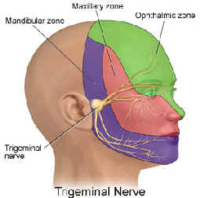
Visual distribution of the trigeminal nerve, the major nerve that transmits sensation from the face to the brain. When pressure is placed on the nerve, most often from a blood vessel, trigeminal neuralgia can result.
Trigeminal neuralgia (TN), also called tic douloureux, is a facial pain disorder that affects over four million patients worldwide. It is characterized by excruciating pain, usually in the lower face, that can become so bad it forces some people to stop working and restrict their social activities, becoming prisoners of the pain.
Billie Jean (BJ) Caperelli of Doylestown, Pa., suffered from the disease for more than 10 years, with many unsuccessful attempts to get rid of the pain. It wasn’t until she came to Penn Medicine to receive a specialized surgery that she got relief.
TN targets the trigeminal nerve, which is one of the most widely distributed nerves in the head and face. Its primary role is to transmit normal touch sensation from the face to the brain. In patients with TN, however, the nerve is distorted usually by an artery as it exits the brain stem. This distortion causes the myelin sheath, the protective coating that surrounds the nerve, to wear away or become damaged. Destruction of the myelin sheath is analogous to removal of the plastic insulation around a live wire, exposing the patient to “short-circuits” of electrical impulse or shocks of pain.
Caperelli experienced short episodes of pain at first, which occurred once, then twice a week, and was treated with a common seizure medication, often the first line of defense for most TN patients. As the years progressed, it took more medication at higher dosages to get Caperelli’s TN under control. By 2014, the medication was no longer enough to control the pain.
TN is known as the “suicide disease” because of the unbearable pain patients suffer. The pain of TN can be extreme and is characterized by sudden, sporadic burning or shock-like facial pain that lasts anywhere from a few seconds to as long as two minutes per episode. The attacks can occur in quick succession and cease or in short episodic bursts, lasting as long as two hours.
“When a flare-up starts, you fall to your knees in pain,” Caperelli said. As her TN worsened, she was forced to cut back to part-time work and abstain from driving. “You get no warning, so when the pain came on, it surged quickly and I was out of commission until it subsided,” she said. Talking, smiling, eating, washing her face, looking at a computer—most anything that required even the slightest movement of her facial muscles—could induce pain.

John Y.K. Lee, MD, an associate professor of Neurosurgery and director of the Penn Center for Cranial Nerve Disorders.
This spring, she underwent surgery, a fully endoscopic microvascular decompression (E-MVD), at Pennsylvania Hospital performed by John Y.K. Lee, MD, an associate professor of Neurosurgery and director of the Penn Center for Cranial Nerve Disorders.
Dr. Lee performed the intricate skull-base surgery using an endoscope that is only one tenth of an inch wide, accessing the base of the trigeminal nerve via a one centimeter opening behind Caperelli’s ear. The endoscope provides visualization of the trigeminal nerve and the offending blood vessels. Once the vessels were located, Lee then placed Teflon between the nerve and blood vessels in order to reconstitute the myelin sheath and thereby relieve her pain.
“I have performed almost 500 retrosigmoid (behind the ear) craniotomies at Penn, and I currently perform more than one or two of these types of operations every week,” said Lee, one of few neurosurgeons in the country with the expertise and cutting-edge technology to perform the fully endoscopic procedure. “In addition, I have pioneered a fully endoscopic procedure which appears to be less invasive than the standard open surgical procedure. This leaves patients with a smaller incision and in my experience, less headaches, which can occur after surgery.”
“Although TN is one of the less common diseases neurosurgeons see, it is without a doubt one of the most debilitating,” he added.
In Caperelli’s case, and in 80 percent of all patients diagnosed with TN, experts are not clear on why these painful symptoms occur, Lee said.
“TN can rob you of your social life and connections, so it remains important for us to let people know that they are not alone,” said Caperelli, who, along with her husband Vince, co-leads the local TN support group through the Facial Pain Association. They will attend the organization’s annual meeting in New York City in October.
Caperelli has been pain-free since the surgery, and is hoping for very long-lasting relief. She is grateful to have found Dr. Lee and his team.